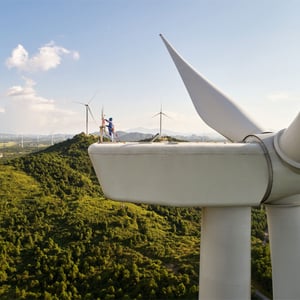Love 'em or loathe 'em, it’s undeniable that Apple, one of the companies held in Booster’s core and socially responsible investment funds, has been leading the way with cool tech, gadgets, and computers since the late '70’s.
Apple’s “think different” ethos has led them to become a renowned, multinational tech giant who design, develop and sell a plethora of consumer electronics, computer software, and online services.
Not only are they still creating future leading tech, Apple has also turned their innovative focus on their environmental impact, committing to reduce their carbon footprint and be carbon neutral by 2030.
This bold goal is very much aligned with the United Nation’s Sustainable Development Goal #13 – “to undertake urgent action to combat climate change and its impacts”.
For Apple, this action plan started back in 2011, and since then they’ve worked to prevent over 3.6 million metric tons of carbon from entering the atmosphere. That’s equivalent to taking more than 791,000 cars off New Zealand roads for a year! Yet over this time, Apple’s total energy use increased by more than four times.
So, how has this tech giant achieved this significant reduction in their carbon footprint?
Sources of energy
Since 2018, Apple has generated electricity from 23 renewable energy projects, or sourced 100% renewable electricity for all of their global facilities. This means their direct operations, including their fully solar-powered headquarters in Cupertino, California, run on 100% renewable energy.
In addition, Apple’s manufacturing supply chain makes up 75% of their overall carbon footprint and around 70% of those emissions come from electricity. Apple has been working on getting their suppliers on board with their target of zero emissions from electricity. As of March 2020, more than 70 suppliers (from over 200) have committed to Apple production using 100% renewable electricity.
By the end of 2020, their Supplier Clean Energy Programme is expected to bring 4.0 gigawatts of new clean energy online. This is the same as charging more than 360 million smartphones*, but will likely only cover one-third of the electricity used by Apple’s global suppliers.
It’s a big goal, but Apple is committed to ensuring their entire supply chain runs on renewable energy by 2030.
Efficient use of energy
During the 2019 financial year, Apple implemented energy efficiency measures, including the use of outside air cooling at some of their data centres and smart LED lighting.
These measures resulted in over 26.4 million kilowatt-hours saved per year. That’s the same as powering 2,154 homes for one year*.
Apple is also integrating energy efficiency early into the design process for new offices or Apple stores. This is to better allow for local conditions such as temperature, humidity, and light. A store prototype has been rolled out at over 20 retail locations, and so far, has resulted in energy savings of up to 20%.
To help their suppliers reduce their energy use, Apple conducted energy audits across 92 facilities participating in their Supplier Energy Efficiency Programme. The audit uncovered opportunities for energy efficiency such as replacing outdated or inefficient heating, cooling and lighting systems and provided the suppliers with a cost-benefit analysis for implementing energy efficiency improvements.
In 2019 alone, Apple’s Supplier Energy Efficiency Programme avoided over 779,000 annualised metric tons of supply chain CO2e. That’s the equivalent of the electricity usage of 132,000 homes for a year!*
Investing for the future
Climate change is affecting every country in the world. We only have to look at the recent droughts, bush fires and extreme weather events to see its very real effects. We all know that we need to make changes to the way we live and consume resources.
Here in New Zealand, we’re lucky that the majority of our electricity is already generated from renewable sources. And, some of us also look to decrease our personal carbon footprint further by recycling, walking, taking public transport instead of driving, eating local produce, using LED lights and making our homes as energy-efficient as possible.
When a multinational giant like Apple commits to an environmental strategy that reduces their impact and overall carbon emissions without impacting profitability, it highlights that environmental action doesn’t have to come at the cost of profits.
In fact, there’s growing evidence that companies who take their Environmental, Social and Governance (ESG) responsibilities seriously also compare well on other aspects of performance.
Apple’s commitment to their environmental strategy will benefit investors, and the environment for years to come.
Article by Leeanna Kohn-Hardy, Finappster
All Apple-related statistics are sourced from Apple.com, Environmental Progress Report, June 2020.
*Calculated using EPA's Greenhouse gas equivalencies calculator

